‘Godzilla Resurgence’ Review: Godzilla gets a worthy reboot
Click to read the full story: ‘Godzilla Resurgence’ Review: Godzilla gets a worthy reboot
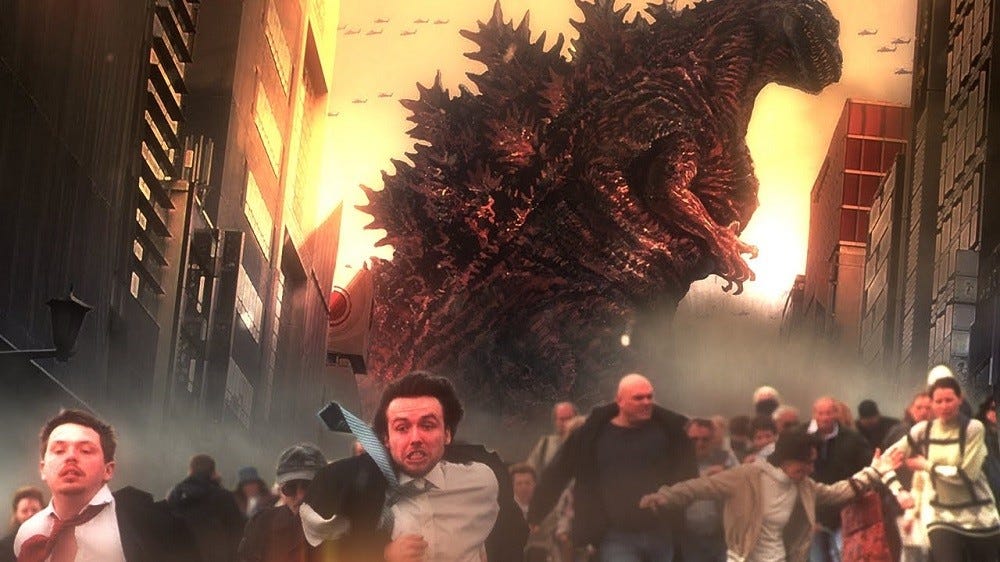
Some time ago, we reviewed the trailer for Godzilla: Resurgence otherwise known as Shin Godzilla in Japan. Unlike other Japanese Godzilla films, this movie is entirely different. All Godzilla films after 1954 were sequels to the original, except this one. Godzilla: Resurgence is a complete reboot which means that Japan gets attacked by Godzilla for the first time with no knowledge of the giant creature and has no countermeasures whatsoever. The trailer was awesome and showed an entirely new Godzilla with new powers such as a tail and dorsal fin lasers. So now we know what those dorsal fins were for. So how was the movie?
For those who want to enjoy Godzilla Resurgence and have not read into Wikipedia on the movie, please stop here and come back to this article the second week of October after seeing the film in the US.
Reception of the film in Japan was great overall. It’s so far their highest grossing movie of 2016. It was shown to a limited degree in foreign countries. Japanese and foreign film critics mostly have good things to say for the movie. This author promised an earlier review as soon as the film went out but circumstances didn’t allow for viewing not to mention the film’s limited run didn’t allow for viewing in the immediate area. That just won’t do for this Godzilla fan, but I managed to score a copy from a friend underground. Once the film comes out on DVD, hopefully with an English dub, it will be added to the collection. The film was good. To elaborate, it was a commendable effort for a production that felt like it was grasping in the dark for a light switch and was rewarded a literal light show in return.

For more than 50 years, Toho made Godzilla films under the pretense that Japan was already familiar with the monster wherein they have at least some preparation or contingency for the monster’s return. Based on that, the plot revolves around some special weapon or another monster for Godzilla to fight and evacuation procedures are already in place and that somehow, the Japanese economy is prepared to bounce back after all the destruction. They prepare special weapons like the Super X, MechaGodzilla, Jet Jaguar, anti-nuclear bacteria, black hole cannons and rail guns. But this time, there’s none of that. Toho must go back to its roots and create a new film that revolves around a thriving modern Japan with an extensive bureaucracy and a neutered military. Toho also needs to differentiate this film from the plethora of city-destroying kaiju films and TV shows that came before. What we can say here is that they did a great job of doing something different and at the same time did a consistent job in putting more human screen time at the forefront.
Godzilla: Resurgence goes between showing the monster madness to mostly clean settings where government officials and agency personnel share discussions about the monster. There is plenty of tension among the characters as they talk about the unprecedented appearance of a giant monster in Japan. Even the destruction looked clean (it’s Japan), but that can be attributed to its mostly daylight settings. Unlike Legendary’s Godzilla, Tri-Star’s Godzilla and Bad Robot’s Cloverfield, the destruction and chaos is not artificially enhanced by darkness and tons of smoke. A constant criticism about many Godzilla films are the long scenes of human discussions and struggles, and it’s a pretty long film. In this film, we get a lesson of supposedly how Japanese bureaucracy and politics work. In Legendary’s Godzilla, the most interesting person of the film was Bryan Cranston whose role was cut short. Again, Godzilla 2014 could have worked out better with Cranston not dying and bonding with his son during the fight with Godzilla and the MUTOs.
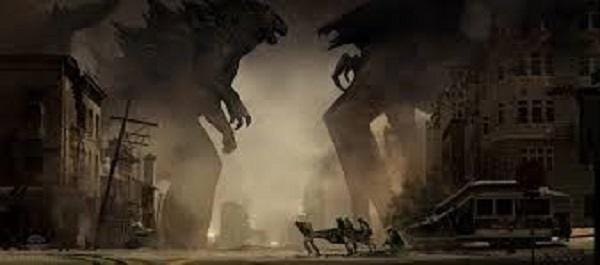
The musical score screams Evangelion due to director Hideaki Anno’s involvement or perhaps the crisis, and action scores are generic for many Japanese films and TV shows. The film also combines the classic Godzilla tracks. The classic Godzilla roar was thankfully kept.
The monster design in this film has plenty of similarities and differences with the classic Godzilla. This is the tallest incarnation of the monster so far. The body structure is similar to older incarnations except for the smaller arms, the face and the chest. Shin Gojira has more monstrous and menacing facial features. At first, it’s small ridiculously round eyes didn’t look well in some shots but gets better when seen from afar along with the entire face. When he roars, he shows plenty of tissue on the opposite sides of the lips. What’s totally new to this Godzilla is the splitting of his lower jaw when he discharges flames and his signature heat beam. Jaw splits seem to be common now when it was first popularized in the second Blade film. It would make sense since Godzilla’s radioactive beam seems to be much more powerful now than it was before. The beam cuts like a knife through buildings instead of blowing them up. The destruction here is quite total as he just doesn’t stomp the city to death, he annihilates it, able to kill every living thing within a certain radius. His chest appears bony instead of muscular as if emphasizing an avian rib cage. The arms seem disappointingly small but could change in future films due to the monster’s continuing evolution.
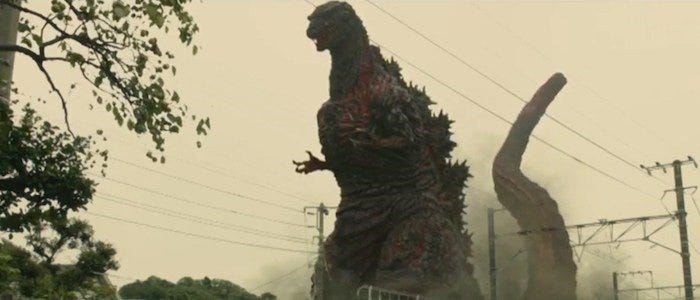
Godzilla here has four different forms. The first is not shown and is simply described as a colony of microorganisms that joined together to feed off nuclear waste dumped into the ocean. The second form was first shown in Tokyo Bay and later seen coming to land as a slithering snake-like creature with large eyes and large gills that splatter noxious organic material. The third form has it standing up and forming small arms stomping much of the surrounding area. The huge round eyes were fish-like emphasizing its marine origin. The final form is what was shown in the trailer being shot at by helicopters and tanks as he marches into Tokyo. Godzilla’s origin and evolution is a drastic departure from his dinosaur origins in the original movie as well as the 90s Godzilla vs. King Ghidorah film. He more shares his origin with his 90s enemy Destroyah who also started out as colonies of deep-sea microorganisms. And speaking of Godzilla vs. Destroyah, Shin Gojira’s skin also shows glowing gaps showing the amount of power within the creature. Traditionally, Godzilla is almost invulnerable. In the movie, he is able to withstand powerful machinegun fire, missiles and artillery but can be hurt with bombs of enough yield such as those used by the US military. To defend against enemies in the air, Godzilla can also fire radiation beams from his tail and dorsal fins. Godzilla becomes immobile after exhausting his stored power. He can also fire targeted lasers against anything that approaches from the air while he’s immobile.
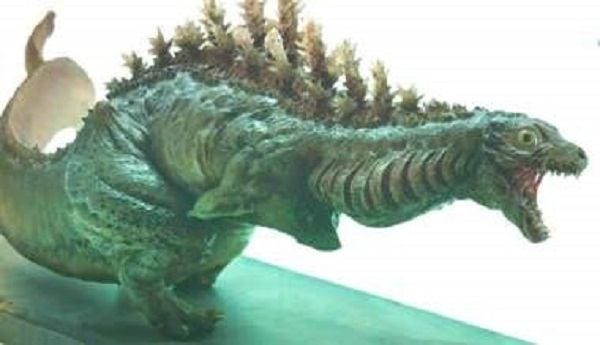
In the movie, Godzilla’s radiation beams are both a cooling and self-defense mechanism. Godzilla was defeated when the Japanese and US forces set him up to use up his beams to the point of exhaustion. They were able to knock him down the ground in order to administer blood coagulants via concrete injector trucks through his mouth, in order to freeze the invincible monster. The alternative was for the US to drop a thermonuclear bomb on Tokyo within a window of two weeks to destroy the immobile Godzilla, a solution unacceptable to the Japanese including the ambitious half-American Japanese envoy.
The movie ends with Godzilla frozen in the middle of the city and it’s unknown what the Japanese intend to do with the monster. The thermonuclear option remains open, and it’s up to the Japanese to put him to sleep as soon as he reawakens. It’s reminiscent of the 70s Mechander Robot cartoon wherein the robot has a 3-minute window to defeat his enemy or get blasted with a powerful bomb from orbit.
[springboard type=”video” id=”1651401″ player=”mtvt006″ width=”480″ height=”400″ ]
Overall, the movie was great, especially during the Godzilla sequences. You’ll need to be attentive to the human sequences to fully understand the film especially if they show it in the original Japanese dub with subtitles this coming October. No doubt the film will be English subbed by then for American audiences. What will be interesting is how Toho will ground Godzilla’s rogues gallery to reality. It would be interesting what origins they come up with monsters such as King Ghidorah and Rodan and how they’ll explain why they can’t find a way to destroy the monster while it’s in stasis.
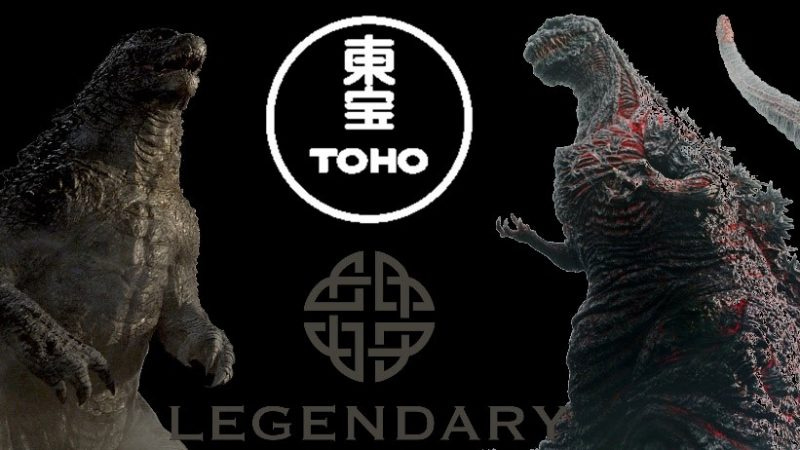
It’s not easy comparing the film to Legendary’s Godzilla. They’re vastly different when it comes to the origin and effects. The effects here look more believable especially the close-ups as Toho used a mixture of CGI and practical effects in contract to Legendary’s where the creatures were mainly CG. In opposition to our earlier statement of this being another response movie to Hollywood, Godzilla: Resurgence has been in the works for some time. The last Godzilla film from Toho was the action-packed Godzilla: Final Wars shown in 2004. Godzilla: Resurgence is slated for a one-week limited release in the US this coming October.
Film Review: ‘Shin Godzilla’ aka ‘Godzilla: Resurgence’
Reviewed on DVD, Houston, Sept. 26, 2016. (At Fantastic Fest, Austin.) MPAA Rating: R. Running time: 120 MIN.
PRODUCTION: (Japan) A Funimation Films (in U.S.) of a Toho Pictures production. Producers: Minami Ichikawa, Taichi Ueda, Yoshihiro Sato, Masaya Shibusawa, Kazutoshi Wadakura. Executive producer: Akihiro Yamauchi. (Original title: “Shin Gojira.”)
CREW: Directors: Hideaki Anno, Shinji Higuchi. Screenplay: Anno. Camera (color): Kosuke Yamada. Editor: Anno.
WITH: Hiroki Hasegawa, Satomi Ishihara, Yatuka Takenouchi, Mikako Ichikawa. (Japanese, English dialogue.)
The post ‘Godzilla Resurgence’ Review: Godzilla gets a worthy reboot appeared first on Movie TV Tech Geeks News By: Marius Manuella
